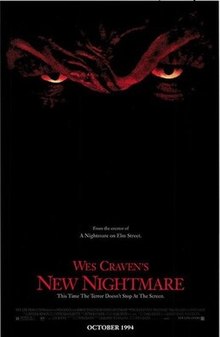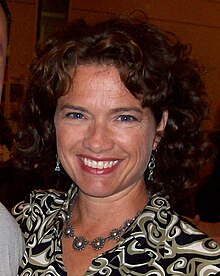
Wesley Earl Craven was an American film director, screenwriter, producer, actor, and editor. Amongst his prolific filmography, Craven was best known for his pioneering work in the horror genre, particularly slasher films, where he mixed horror cliches with humor and satire. Craven has commonly been recognized as one of the greatest masters of the horror genre due to the cultural impact and influence of his work.

A Nightmare on Elm Street is an American supernatural slasher media franchise consisting of nine films, a television series, novels, comic books, and various other media. The franchise began with the film A Nightmare on Elm Street (1984), written and directed by Wes Craven. The overall plot of the franchise centers around the fictional character Fred "Freddy" Krueger, the apparition of a former child killer who was burned alive by the vengeful parents of his victims, who returns from the grave to terrorize and kill the teenage residents of the fictional Springwood, Ohio in their dreams. Craven returned to the franchise to co-script the second sequel, A Nightmare on Elm Street 3: Dream Warriors (1987), and to write/direct Wes Craven's New Nightmare (1994). The films collectively grossed $472 million at the box office worldwide.

Freddy Krueger is the antagonist of the A Nightmare on Elm Street horror film franchise. Created by Wes Craven, he made his debut in Craven's A Nightmare on Elm Street (1984) as the malevolent spirit of a child killer who had been burned to death by his victims' parents after evading prison. Krueger goes on to murder his victims in their dreams, causing their deaths in the real world as well. In the dream world, he is a powerful force and seemingly invulnerable. However, whenever Freddy is pulled back into the real world, he has normal human vulnerabilities and can be destroyed. He is commonly identified by his burned, disfigured face, dirty red-and-green-striped sweater and brown fedora, and trademark metal-clawed, brown leather, right hand glove. This glove was the product of Krueger's own imagination, having welded the blades himself before using it to murder many of his victims, both in the real and dream worlds. Over the course of the film series, Freddy has battled several reoccurring survivors including Nancy Thompson and Alice Johnson. The character was consistently portrayed by Robert Englund in the original film series as well as in the television spin-off Freddy's Nightmares.
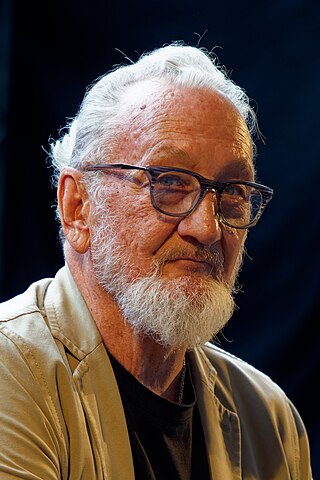
Robert Barton Englund is an American actor and director, best known for playing the supernatural serial killer Freddy Krueger in the Nightmare on Elm Street film series. Classically trained at the Royal Academy of Dramatic Art, Englund began his career as a stage actor in regional theatre, and made his film debut in Buster and Billie in 1974. After supporting roles in films in the 1970s such as Stay Hungry, A Star Is Born, and Big Wednesday, Englund had his breakthrough as the resistance fighter Willie in the miniseries V in 1983. Following his performance in the original A Nightmare on Elm Street in 1984, he became closely associated with the horror film genre, and is widely-regarded as one of its iconic actors.

Heather Elizabeth Langenkamp is an American actress, writer, director, disc jockey, and producer. Although she has acted in many film genres, she is primarily known for her work in horror films, in addition to her work on television sitcoms. Langenkamp has been referred to as a scream queen and was inducted into the Fangoria Chainsaw Hall of Fame in 1995.

Freddy's Dead: The Final Nightmare is a 1991 American slasher film and the sixth film in the A Nightmare on Elm Street franchise. It is a sequel to A Nightmare on Elm Street 5: The Dream Child and was originally intended to be the final installment of the series; Wes Craven's New Nightmare was released three years later but takes place outside the series canon. A canonical crossover/sequel, Freddy vs. Jason, was released in 2003. This was New Line Cinema's first 3D film release.
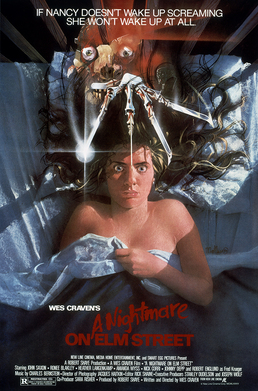
A Nightmare on Elm Street is a 1984 American supernatural slasher film written and directed by Wes Craven and produced by Robert Shaye. It is the first installment in the A Nightmare on Elm Street franchise and stars Heather Langenkamp, John Saxon, Ronee Blakley, Robert Englund as Freddy Krueger, and Johnny Depp in his film debut. The film's plot concerns a group of teenagers who are targeted by Krueger, an undead child killer who can murder people through their dreams, as retribution against their parents who burned him alive.

A Nightmare on Elm Street 3: Dream Warriors is a 1987 American fantasy slasher film directed by Chuck Russell in his feature directorial debut. The story was developed by Wes Craven and Bruce Wagner and is the third installment in the Nightmare on Elm Street franchise and stars Heather Langenkamp, Patricia Arquette, Larry Fishburne, Priscilla Pointer, Craig Wasson, and Robert Englund as Freddy Krueger. Nancy Thompson, now a psychiatrist, and Kristen, a patient who can bring others into her own dreams, team up with other kids to launch a daring rescue into the dreamland and save a child from Freddy Krueger.

A Nightmare on Elm Street 4: The Dream Master is a 1988 American fantasy slasher film directed by Renny Harlin, and is the fourth installment in the A Nightmare on Elm Street franchise. Serving as a sequel to A Nightmare on Elm Street 3: Dream Warriors (1987), the film follows Freddy Krueger who, following the death of Nancy Thompson and completing his revenge against the families who killed him, reappears in the dreams of Kristen Parker, Joey Crusel, and Roland Kincaid, where he uses Kristen's best friend, Alice Johnson, to gain access to new victims in order to satiate his murderous needs. The Dream Master is often popularly referred to as "the MTV Nightmare" of the franchise.
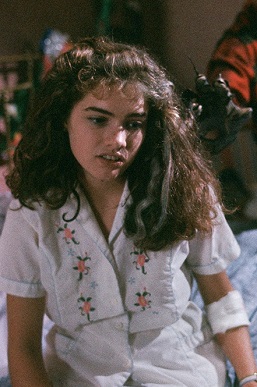
Nancy Thompson is a fictional character in the A Nightmare on Elm Street franchise. She first appears in A Nightmare on Elm Street (1984) as a teenager hunted in her dreams by enigmatic serial killer Freddy Krueger. In this film, she was portrayed by Heather Langenkamp—who reprises the role in the sequel, A Nightmare on Elm Street 3: Dream Warriors (1987). Langenkamp later portrayed a fictional version of herself who embodies the role of Nancy in Wes Craven's New Nightmare (1994). A reimagined version of the character, Nancy Holbrook, is portrayed by Rooney Mara in the 2010 remake.

Kristen Parker is a character from the A Nightmare on Elm Street series. She is a co-protagonist and final girl of the third film of the series A Nightmare on Elm Street 3: Dream Warriors and the false protagonist in the following film A Nightmare on Elm Street 4: The Dream Master, and has appeared in various merchandise as well. She is played by actress Patricia Arquette in Dream Warriors and Tuesday Knight in The Dream Master. She is the central member of the titular Dream Warriors, seven teens who have to learn to fight as a group in order to survive their spectral tormentor, enigmatic murderer Freddy Krueger, and has the ability to bring others into her dreams as well as being an Olympic-level acrobat in her dreams.

A Nightmare on Elm Street is a 2010 American supernatural slasher film directed by Samuel Bayer, written by Wesley Strick and Eric Heisserer, and starring Jackie Earle Haley, Kyle Gallner, Rooney Mara, Katie Cassidy, Thomas Dekker, and Kellan Lutz. Produced by Michael Bay and Platinum Dunes, it is a remake of Wes Craven's 1984 film of the same name, as well as the ninth overall installment of the Nightmare on Elm Street franchise. The film is set in a fictitious town in Ohio and centers on a group of teenagers living on one street who are stalked and murdered in their dreams by a disfigured man named Freddy Krueger. The teenagers discover that they all share a common link from their childhood that makes them targets for Krueger.

Never Sleep Again: The Elm Street Legacy is a 2010 American direct-to-video documentary film that chronicles the entire Nightmare on Elm Street franchise, except for the 2010 remake. The documentary also explores the rise of New Line Cinema. Written by Thommy Hutson, produced by Daniel Farrands and Thommy Hutson, and co-directed by Daniel Farrands and Andrew Kasch. Heather Langenkamp, who portrayed Nancy Thompson in three of the Nightmare films, served as the project's executive producer and narrator. As of February 2019, the documentary has grossed over $400k from video sales.
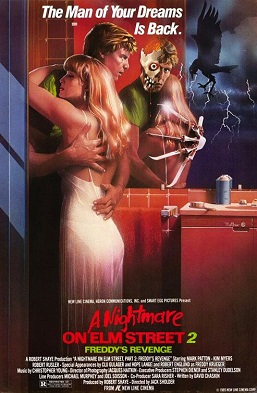
A Nightmare on Elm Street 2: Freddy's Revenge is a 1985 American supernatural slasher film directed by Jack Sholder and written by David Chaskin. It stars Mark Patton, Kim Myers, Robert Englund as Freddy Krueger, and Robert Rusler. It is the second installment in the A Nightmare on Elm Street franchise. The film follows Jesse Walsh, a teenager who begins having recurring nightmares about Freddy Krueger after moving into the former home of Nancy Thompson from the first film.

I Am Nancy is a 2011 American documentary that follows actress Heather Langenkamp as she explores her role as Nancy Thompson in the A Nightmare on Elm Street films, the fandom that surrounds the franchise, and why most of it focuses on Freddy Krueger, rather than Nancy.

Christina "Tina" Gray is a fictional character in the A Nightmare on Elm Street franchise. She was created by Wes Craven. The character was portrayed by Amanda Wyss in the original film and Katie Cassidy in the 2010 film. Julianna Damm also portrayed the character as a preadolescent in the 2010 film's flashbacks and dream sequences. A high school student whose death is the catalyst for the events of the series, Gray is the false protagonist of the 1984 original film. She also appears in the novels, Wes Craven's New Nightmare (1994), Freddy vs. Jason (2003), 2010 reboot, merchandise based on the films, and a claymation version of the character is shown in the documentary Never Sleep Again: The Elm Street Legacy (2010). The imagery featuring Gray in the body bag during the dream sequences have been regarded as iconic.

Jesse Walsh is a fictional character in the A Nightmare on Elm Street franchise. He was created by David Chaskin and portrayed by Mark Patton. Making his debut in A Nightmare on Elm Street 2: Freddy's Revenge in 1985, Jesse became the first male protagonist of the series. In Freddy's Revenge, Freddy enacts a plan to possess Jesse, using his body to kill in the real world, slowly gaining the strength to manifest his form physically. Outside of the films, Jesse has a main role in the novels. Because of the LGBT representation in a mainstream film, Jesse has developed a large fan base in the gay community and has been called a gay icon. Jesse has been observed by some scholars as a variation of the "final girl" slasher film archetype, and instead a "final boy".
1428 Elm Street, also known as [the] Elm Street House, is a fictional residential house and street address in Springwood, Ohio, and is an important location in the A Nightmare on Elm Street franchise, where it has been the home of Nancy Thompson and her mother, later Jesse Walsh and his family, and finally Lori Campbell and her father, throughout the film series. It has also been implied to have been Freddy Krueger's home at some point before the events that take place in the films. It appears in some form in nearly all the films, as well as literature, comic books, toys, and music videos. The house, like Freddy Krueger, Nancy Thompson, Tina Gray, and Kristen Parker, were all conceived by Wes Craven.
